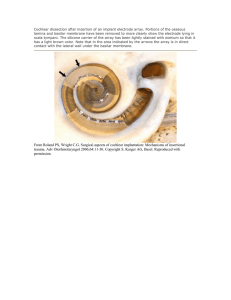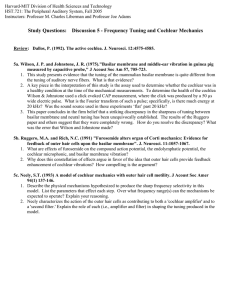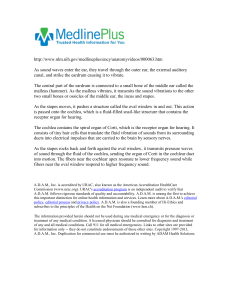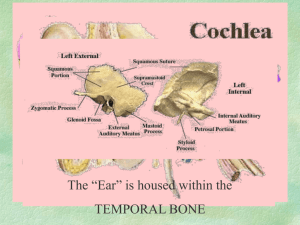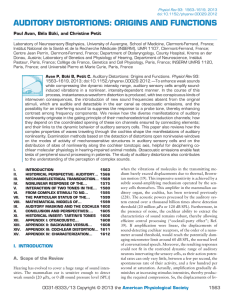Harvard-MIT Division of Health Sciences and Technology
advertisement
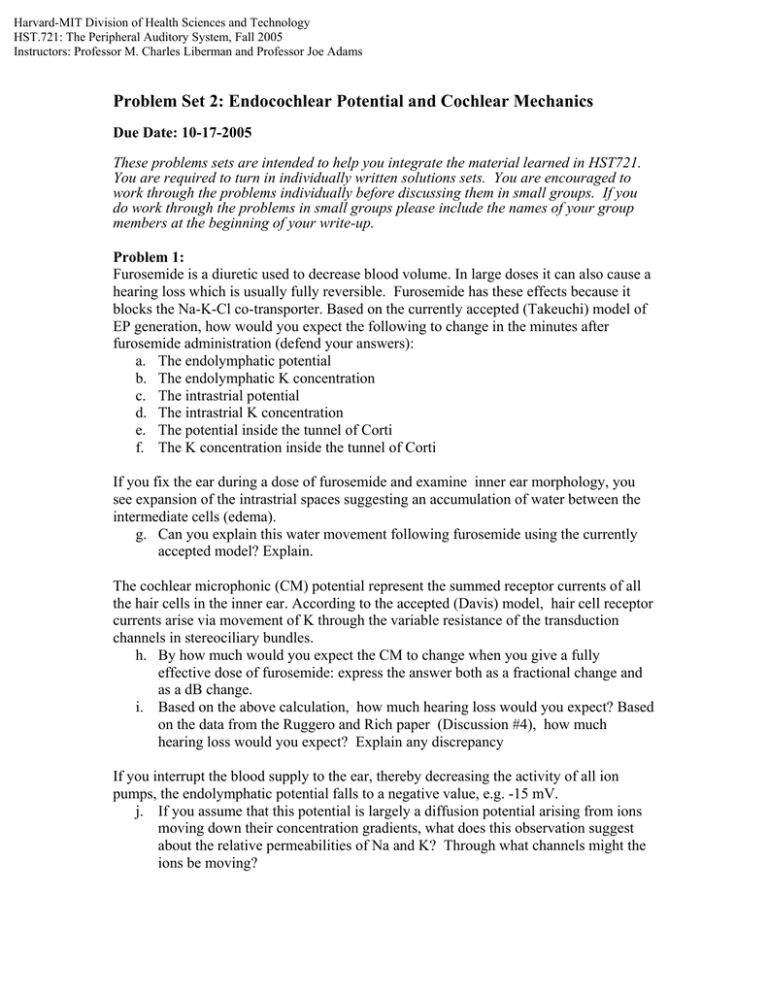
Harvard-MIT Division of Health Sciences and Technology HST.721: The Peripheral Auditory System, Fall 2005 Instructors: Professor M. Charles Liberman and Professor Joe Adams Problem Set 2: Endocochlear Potential and Cochlear Mechanics Due Date: 10-17-2005 These problems sets are intended to help you integrate the material learned in HST721. You are required to turn in individually written solutions sets. You are encouraged to work through the problems individually before discussing them in small groups. If you do work through the problems in small groups please include the names of your group members at the beginning of your write-up. Problem 1: Furosemide is a diuretic used to decrease blood volume. In large doses it can also cause a hearing loss which is usually fully reversible. Furosemide has these effects because it blocks the Na-K-Cl co-transporter. Based on the currently accepted (Takeuchi) model of EP generation, how would you expect the following to change in the minutes after furosemide administration (defend your answers): a. The endolymphatic potential b. The endolymphatic K concentration c. The intrastrial potential d. The intrastrial K concentration e. The potential inside the tunnel of Corti f. The K concentration inside the tunnel of Corti If you fix the ear during a dose of furosemide and examine inner ear morphology, you see expansion of the intrastrial spaces suggesting an accumulation of water between the intermediate cells (edema). g. Can you explain this water movement following furosemide using the currently accepted model? Explain. The cochlear microphonic (CM) potential represent the summed receptor currents of all the hair cells in the inner ear. According to the accepted (Davis) model, hair cell receptor currents arise via movement of K through the variable resistance of the transduction channels in stereociliary bundles. h. By how much would you expect the CM to change when you give a fully effective dose of furosemide: express the answer both as a fractional change and as a dB change. i. Based on the above calculation, how much hearing loss would you expect? Based on the data from the Ruggero and Rich paper (Discussion #4), how much hearing loss would you expect? Explain any discrepancy If you interrupt the blood supply to the ear, thereby decreasing the activity of all ion pumps, the endolymphatic potential falls to a negative value, e.g. -15 mV. j. If you assume that this potential is largely a diffusion potential arising from ions moving down their concentration gradients, what does this observation suggest about the relative permeabilities of Na and K? Through what channels might the ions be moving? Problem 2: (a) On a set of clearly labeled graphs, draw the basilar membrane displacement vs. sound pressure curves you would expect from a spot 5 mm from the base in a healthy mammalian cochlea. On one graph show the result for tonal stimulation at the best frequency for that spot (assume ~8 kHz), on the other show the result for tonal stimulation at a much lower frequency (~1 kHz). Make sure you label the axes, including both the numerical values and the units, and indicate whether the axes are logarithmic or linear. (b) On the graphs, indicate how these basilar membrane displacement vs. sound pressure curves would change after the animal died. For clarity, superimpose the "healthy ear" curve you plotted above on the "dead ear" curve in each panel. (c) Discuss which of these "input-output curves" show linear or non-linear behavior, and briefly describe a likely source of any non-linearity observed in these curves. Problem 3: When two primary tones, f1 and f2, are presented simultaneously to the ear in an appropriate frequency ratio (f2/f1 = ~1.25), a number of distortion product otoacoustic emissions (DPOAEs) can be measured in the ear canal sound pressure as well as in the motion of the basilar membrane. The strongest distortion component is usually at the frequency 2f1-f2. The current model of DPOAE generation states that when outer hair cells (OHCs) in one cochlear location are driven simultaneously at the two input frequencies, f1 and f2, the saturating non-linearity in the mechano-electric transduction apparatus produces a distortion component at 2f1-f2 in the receptor potentials which drives the OHC motors. Experimentally, it is observed that cochlear insults which target the OHCs decrease the DPOAEs. a) Given what you have learned about cochlear mechanics, is it more reasonable to propose that the DPOAEs arise near the cochlear region tuned to f2 or the region tuned to f1? Explain your reasoning in words and graphs. In mammalian ears, empirical observation shows that the DPOAEs are often largest when the level of the f1 tone is 10 - 20 dB greater than that of f2. b) Given what you have learned about cochlear mechanics, can you explain why this might be?

